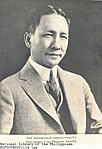| ||||||||||||||||||||||
All 90 seats in the House of Representatives of the Philippines 46 seats needed for a majority | ||||||||||||||||||||||
|---|---|---|---|---|---|---|---|---|---|---|---|---|---|---|---|---|---|---|---|---|---|---|
| ||||||||||||||||||||||
| ||||||||||||||||||||||
Elections for the members of the House of Representatives were held on June 3, 1919 pursuant to the Philippine Organic Act of 1902, which prescribed elections for every three years. The ruling Nacionalista Party increased its majority from 75 seats out of 90 seats in the 1916 election to 83 out of 90 seats in this election. The elected representatives would serve in the 5th Philippine Legislature from 1919 to 1922.
Results
|
| Party | Seats | +/– | |
|---|---|---|---|
| Nacionalista Party | 83 | +8 | |
| Democrata Party | 4 | +2 | |
| Independent | 3 | −2 | |
| Total | 90 | 0 | |
| Source: Dieter Nohlen; Florian Grotz; Christof Hartmann; Graham Hassall; Soliman M. Santos (15 November 2001). Elections in Asia and the Pacific: A Data Handbook: Volume II: South East Asia, East Asia, and the South Pacific. OUP Oxford. ISBN 9780199249596. | |||
References
- Paras, Corazon L. (2000). The Presidents of the Senate of the Republic of the Philippines. Giraffe Books. ISBN 971-8832-24-6.
- Pobre, Cesar P. (2000). Philippine Legislature 100 Years. Philippine Historical Association. ISBN 971-92245-0-9.
| General elections | |
|---|---|
| Presidential elections | |
| Senate elections | |
| House elections | |
| Constitutional conventions | |
| Local elections | |
| Barangay elections | |
| Referendums | |


